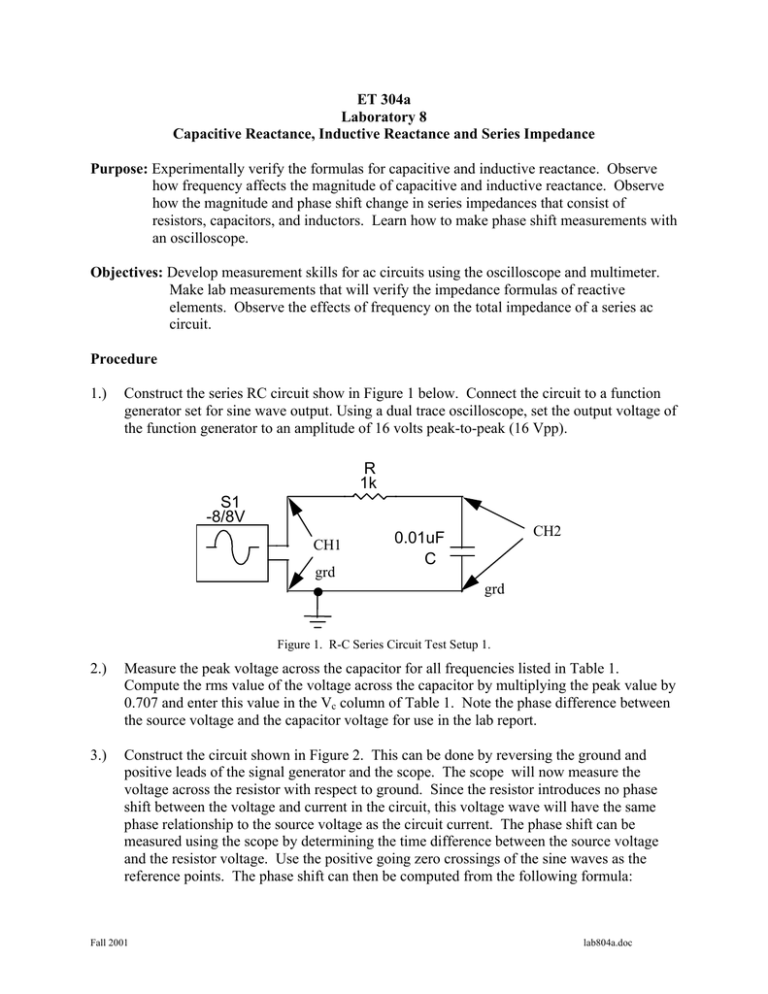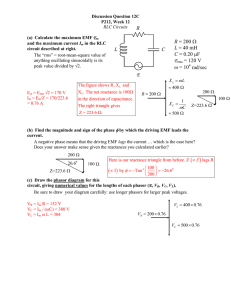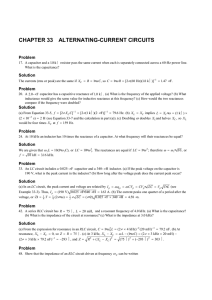ET 304a
advertisement

ET 304a Laboratory 8 Capacitive Reactance, Inductive Reactance and Series Impedance Purpose: Experimentally verify the formulas for capacitive and inductive reactance. Observe how frequency affects the magnitude of capacitive and inductive reactance. Observe how the magnitude and phase shift change in series impedances that consist of resistors, capacitors, and inductors. Learn how to make phase shift measurements with an oscilloscope. Objectives: Develop measurement skills for ac circuits using the oscilloscope and multimeter. Make lab measurements that will verify the impedance formulas of reactive elements. Observe the effects of frequency on the total impedance of a series ac circuit. Procedure 1.) Construct the series RC circuit show in Figure 1 below. Connect the circuit to a function generator set for sine wave output. Using a dual trace oscilloscope, set the output voltage of the function generator to an amplitude of 16 volts peak-to-peak (16 Vpp). R 1k S1 -8/8V CH1 grd CH2 0.01uF C grd Figure 1. R-C Series Circuit Test Setup 1. 2.) Measure the peak voltage across the capacitor for all frequencies listed in Table 1. Compute the rms value of the voltage across the capacitor by multiplying the peak value by 0.707 and enter this value in the Vc column of Table 1. Note the phase difference between the source voltage and the capacitor voltage for use in the lab report. 3.) Construct the circuit shown in Figure 2. This can be done by reversing the ground and positive leads of the signal generator and the scope. The scope will now measure the voltage across the resistor with respect to ground. Since the resistor introduces no phase shift between the voltage and current in the circuit, this voltage wave will have the same phase relationship to the source voltage as the circuit current. The phase shift can be measured using the scope by determining the time difference between the source voltage and the resistor voltage. Use the positive going zero crossings of the sine waves as the reference points. The phase shift can then be computed from the following formula: Fall 2001 lab804a.doc Δt ⋅ 360o T Δt = the time difference between the positive going zero crossings. T = the period of the sine wave which is 1/f with frequency in Hertz. φ = phase shift in degrees. φ= Where : Make sure that the traces of the scope are both referenced to ground before starting this and any other measurement with the instrument. 0.01uF S1 -8/8V C CH2 R CH1 1k grd grd Figure 2. RC Series Impedance Test Setup 2. 4.) Compute the value of circuit current magnitude, I by dividing the rms value of VR by the value of R. Record this value scaled to mA in Table 2. Using this data and the values of Vc compute the value of reactance for each test frequency using Ohm's law and place the result in Table 2 for future use. 5.) Compute the total circuit impedance by dividing the source voltage phasor by the circuit current phasor. The circuit current phasor is I∠φ and the source voltage phasor is Vs∠0, where Vs is the rms value of the source voltage. Place these results in Table 2 for future use. 6.) Build the circuit shown in Figure 3 using the inductance substitution box available in the lab cabinets. The resistor Rc represent the dc resistance of the inductor and in not actually connected in the circuit. Find the value of Rc by measuring the resistance of the coil with the DVM in the lab. Record this value for later use. 7.) Measure the peak voltage across the inductor for all frequencies listed in Table 3. Compute the rms value of the voltage across the inductor by multiplying the peak value by 0.707 and enter this value in the VL column of Table 3. Note the phase difference between the source voltage and the capacitor voltage for use in the lab report. Fall 2001 2 lab804a.doc R 1k Rc S1 -8/8V CH1 CH2 100mH L grd grd Figure 3. RL Series Impedance Test Circuit 1 8.) Construct the circuit shown in Figure 4. This can be done by reversing the ground and positive leads of the signal generator and the scope. The scope will now measure the voltage across the resistor with respect to ground. Since the resistor introduces no phase shift between the voltage and current in the circuit, this voltage wave will have the same phase relationship to the source voltage as the circuit current. The phase shift can be measured using the scope by determining the time difference between the source voltage and the resistor voltage. Use the positive going zero crossings of the sine waves as the reference point. Compute the phase shift by using the formula shown in step 3. Rc L 1k S1 -8/8V R CH1 100mH grd grd Figure 4. RL Series Circuit Test Setup 2. 9.) Compute the value of circuit current magnitude, I by dividing the rms value of VR by the value of R. Record this value scaled to mA in Table 4. Using this data and the values of VL compute the value of reactance for each test frequency using Ohm's law and place the result in Table 4 for future use. Fall 2001 3 lab804a.doc 10.) Compute the total circuit impedance by dividing the source voltage phasor by the circuit current phasor. The circuit current phasor is I∠φ and the source voltage phasor is Vs∠0, where Vs is the rms value of the source voltage. Place these results in Table 4 for future use. Theoretical Calculations For the RC series circuit, compute the value of Xc for each frequency in Table 1 using the formula. Also compute the theoretical value of total series impedance. Give the results in polar form. For the series RL circuit, compute the value of XL of each frequency in Table 3 using the formula and compute the theoretical value of the total series impedance. Include the measured value of Rc in the theoretical calculation of Zt. Also give these results in polar form Graphs and Plots Construct the following plots for the lab report. Plot the theoretical and computed values of Xc on the same set of axis with frequency on the xaxis and the magnitudes of Xc on the y-axis. Plot the theoretical and computed values of Zt for the RC circuit. Make one plot the graphs of both Z magnitudes and one of the graphs of both phase angles. Repeat the same two sets of plots for the RL series circuit data. Note: This is a good lab to use either MathCad or Excel for repeated calculations. This will cut down on the preparation time of the report. See the MathCad tutorial handout that I gave you for how to make these kinds of graphs using that software. Fall 2001 4 lab804a.doc Frequency (Hz) Vc Capacitor voltage (Vrms) Table 1 RC Series Impedance Data VR T = 1/f ΔT Time Period of sine difference Resistor voltage (Vrms) (μS) (μS) φ Phase shift between Vs and I (deg) 1 kHz 5 kHz 10 kHz 20 kHz 30 kHz 40 kHz 50 kHz 60 kHz 70 kHz 80 kHz 90 kHz 100 kHz Table 2 Computed values of Current, Capacitive Reactance, and Impedance Frequency I circuit Xc =Vc/I Zt=Vs/I (Hz) current (mA) computed Xc Computed Zt 1 kHz 5 kHz 10 kHz 20 kHz 30 kHz 40 kHz 50 kHz 60 kHz 70 kHz 80 kHz 90 kHz 100 kHz Fall 2001 5 lab804a.doc Table 3 RL Series Impedance Data Frequency (Hz) VL Inductor voltage (Vrms) VR Resistor voltage (Vrms) T = 1/f Period of sine (μS) ΔT Time difference (μS) φ Phase shift between Vs and I (deg) 1 kHz 5 kHz 10 kHz 20 kHz 30 kHz 40 kHz 50 kHz 60 kHz 70 kHz 80 kHz 90 kHz 100 kHz Table 2 Computed values of Current, Inductive Reactance, and Impedance Frequency I circuit XL =VL/I Zt=Vs/I (Hz) current (mA) computed XL Computed Zt 1 kHz 5 kHz 10 kHz 20 kHz 30 kHz 40 kHz 50 kHz 60 kHz 70 kHz 80 kHz 90 kHz 100 kHz Fall 2001 6 lab804a.doc

